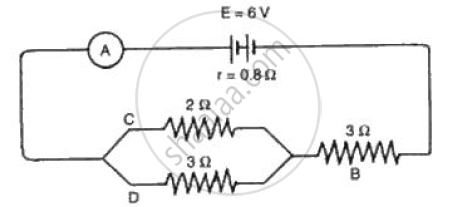Advertisements
Advertisements
Question
Solution
APPEARS IN
RELATED QUESTIONS
In which direction do electrons flow?
An electric bulb is rated as 10 W, 220 V. How many of these bulbs can be connected in parallel across the two wires of 220 V supply line if the maximum current which can be drawn is 5 A?
Find the potential difference required to pass a current of 0.2 A in a wire of resistance 20Ω
The circuit diagram (Fig.) shows a battery of e.m.f. 6 volts and internal
resistance of 0.8 Ω oonnected in series. Find the
(a) Current reoorded by the ammeter,
(b) P.d. across the terminals of the resistor B,
( c) Current passing through each of the resistors B, C and D, and
( d) P.d. across the terminals of the battery.

A current of 0.2 A flows through a wire whose ends are at a potential difference of 15 V. Calculate:
(i) The resistance of the wire, and
(ii) The heat energy produced in 1 minute.
A bulb is connected to a battery of p.d. 4 V and internal resistance 2.5 Ω . A steady current of 0.5 A flows through the circuit. Calculate:
The resistance of the bulb
Explain, why the potential difference across the terminals of a cell is more when the cell is not in use than it is when the cell is being used.
The SI unit for electric current is the coulomb.
The flow of electric charge per unit time is called potential difference.
